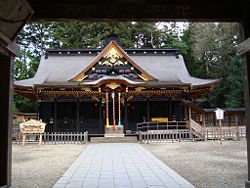- Ōsaki Hachiman-gū
-
Ōsaki Hachiman-gū
大崎八幡宮Haiden of Ōsaki Hachiman-gū Information Type Hachiman Address 4-6-1 Hachiman, Aoba-ku, Sendai, Miyagi Website Homepage Ōsaki Hachiman-gū (大崎八幡宮) is a Shinto shrine in Aoba-ku, Sendai, Miyagi, Japan. The main shrine building (社殿 shaden) has been designated a National Treasure of Japan.
Contents
History
The construction of the present shaden was ordered by Date Masamune. Craftsmen in the service of the Toyotomi family executed the order and built the shrine from 1604 to 1607. At the start of the Meiji period the shrine was called Ōsaki Hachiman Jinja. In consideration of historical circumstances, the original name was reinstated in June 1997. On November 22, 1952, the shaden was designated as National Treasure.
Architecture
The shaden is the oldest extant ishi-no-ma-zukuri (石の間造) structure and an example of Azuchi-Momoyama architecture. It is a single-storied structure consisting of a main sanctuary (honden) and a worship hall (haiden) which are joined via a connecting passage called ishi-no-ma. All three structures are under a single roof which is covered with shake shingles.[1][2]
The honden is a 5 ken by 3 ken structure with a hip-and-gable, irimoya style roof to which a simple gabled roof of the 1 ken by 1 ken ishi-no-ma connects. The haiden is also 3 ken wide. The structure is 7 ken long at the front and 5 ken at the back where the ishi-no-ma is attached. Its roof is like that of the honden of the hip-and-gable type. On the front it has an attached triangular dormer with a decorative bargeboard of strongly concave shape, a chidori hafu (千鳥破風 lit. "plover gable").[3] The entrance is covered by a 5 ken wide step canopy with an undulating karahafu gable at eave ends[4] (nokikarahafu).[2]
See also
- List of National Treasures of Japan (shrines)
References
- ^ "Ōsaki Hachiman Shrine – English information". Ōsaki Hachiman Shrine. http://www.okos.co.jp/oosaki/img/english.pdf. Retrieved 2009-11-04.
- ^ a b "国指定文化財 データベース [Database of National Cultural Properties]" (in Japanese). Agency for Cultural Affairs. 2008-11-01. http://www.bunka.go.jp/bsys/index.asp. Retrieved 2009-04-16.
- ^ "chidori hafu". JAANUS – Japanese Architecture and Art Net User System. http://www.aisf.or.jp/~jaanus/deta/c/chidorihafu.htm. Retrieved 2009-11-08.
- ^ "karahafu". JAANUS – Japanese Architecture and Art Net User System. http://www.aisf.or.jp/~jaanus/deta/k/karahafu.htm. Retrieved 2009-11-08.
External links
- Ōsaki Hachiman-gū official site (Japanese)
- Ōsaki Hachiman-gū English pamphlet (English)
Shinto shrine Shinto architecture Buildings - chōzuya or temizuya
- haiden
- heiden
- hokora
- honden / shinden / shōden
- kagura-den
- massha
- sessha
Architectonic elements Styles - hirairi-zukuri
- tsumairi-zukuri
- gongen-zukuri
- hachiman-zukuri
- hiyoshi-zukuri
- irimoya-zukuri
- ishi-no-ma-zukuri
- kasuga-zukuri
- kibitsu-zukuri
- misedana-zukuri
- nagare-zukuri
- ōtori-zukuri
- owari-zukuri
- ryōnagare-zukuri
- shinmei-zukuri
- sumiyoshi-zukuri
- taisha-zukuri
Others Implements Main kami Staff Head shrines1 - Fushimi Inari Taisha
- Usa Hachiman-gū
- Ise Grand Shrine
- Dazaifu Tenman-gū
- Munakata Taisha
- Suwa Taisha
- Hiyoshi Taisha
- Kumano Nachi Taisha
- Tsushima Shrine
- Yasaka Shrine
Miscellaneous 1 (in order of the size of the shrine network they head)
Categories:- Shinto shrines in Miyagi Prefecture
- Sendai
- Date clan
- National Treasures of Japan
Wikimedia Foundation. 2010.

